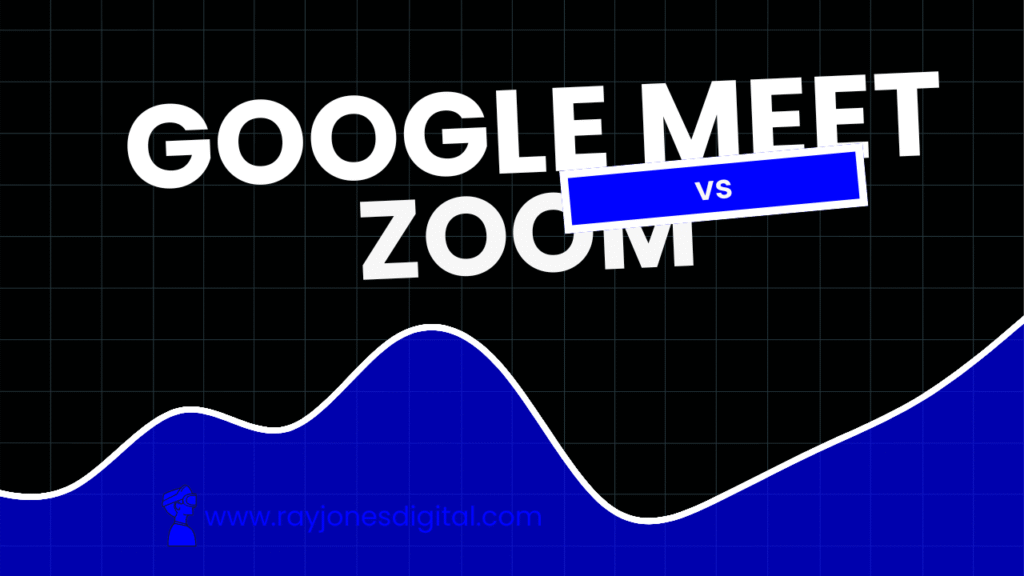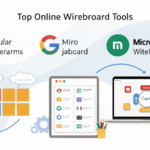
Remote work has fundamentally changed how we communicate, with video conferencing becoming essential for business operations. Two platforms dominate this space: Google Meet, with its seamless integration into Google Workspace, and Zoom, renowned for its robust features and reliability.
Both solutions promise to streamline your virtual meetings, but they cater to different needs and preferences. Google Meet emphasises simplicity and integration within Google’s ecosystem, while Zoom offers comprehensive features and customisation options. Understanding their distinct advantages will help you choose the platform that best supports your team’s communication needs.
What is Google Meet?
Google Meet emerged as Google’s answer to professional video conferencing, replacing the consumer-focused Hangouts. Launched in 2017, this platform integrates seamlessly with Google Workspace (formerly G Suite), making it a natural choice for organisations already using Gmail, Google Drive, and Google Calendar.
The platform prioritises security and ease of use, requiring no software downloads for participants. Users can join meetings directly through web browsers or mobile apps, reducing friction for external attendees. Google Meet’s strength lies in its straightforward approach—meetings start with a single click from calendar invites.
Recent updates have introduced advanced features like breakout rooms, live captions, and recording capabilities. These additions position Google Meet as a serious competitor to established video conferencing platforms whilst maintaining its user-friendly foundation.
What is Zoom?
Zoom has become synonymous with video conferencing, experiencing explosive growth during the pandemic. Founded in 2011, this platform built its reputation on reliability, audio quality, and comprehensive feature sets that cater to various meeting types and sizes.
The platform offers extensive customisation options, from virtual backgrounds to advanced meeting controls. Zoom’s flexibility allows organisations to tailor their video conferencing experience to specific needs, whether hosting webinars, conducting training sessions, or facilitating team meetings.
Zoom’s ecosystem extends beyond basic video calls, incorporating features like Zoom Rooms for conference room integration, Zoom Webinar for large-scale presentations, and Zoom Phone for unified communications. This comprehensive approach makes Zoom a complete communication solution for many organisations.
Key Features Comparison
Meeting Capacity and Duration
Google Meet provides generous meeting limits for Google Workspace users. Basic plans support up to 100 participants for 60 minutes, whilst premium plans extend this to 500 participants with no time restrictions. Free users can host meetings with up to 100 participants for 60 minutes.
Zoom’s capacity varies significantly across plans. The basic free tier allows 40-minute meetings with up to 100 participants, whilst paid plans support up to 1,000 participants with no time limits. Zoom’s webinar functionality can accommodate even larger audiences, making it suitable for major events and presentations.
Audio and Video Quality
Both platforms deliver high-quality audio and video, but their approaches differ. Google Meet automatically adjusts quality based on network conditions and device capabilities, prioritising connection stability over maximum resolution. This approach ensures consistent performance across various devices and internet speeds.
Zoom offers more granular control over audio and video settings. Users can manually adjust video resolution, enable HD video, and fine-tune audio settings. The platform’s advanced audio processing includes noise suppression and echo cancellation, contributing to superior call quality in challenging environments.
Screen Sharing and Collaboration
Google Meet integrates naturally with Google Workspace applications. Users can share their entire screen, specific applications, or individual browser tabs. The platform allows real-time collaboration on Google Docs, Sheets, and Slides during meetings, enhancing productivity for teams already using these tools.
Zoom provides comprehensive screen sharing options with annotation capabilities. Participants can annotate shared screens, highlight important information, and collaborate visually during presentations. The platform also supports multiple users sharing screens simultaneously, facilitating dynamic presentations and demonstrations.
Security Features
Security concerns have shaped both platforms’ development priorities. Google Meet implements robust security measures, including encryption in transit, meeting codes that expire after meetings end, and automatic removal of participants who haven’t joined within a specified timeframe. The platform also provides admin controls for managing meeting access and permissions.
Zoom faced security challenges early in the pandemic but responded with significant improvements. The platform now includes end-to-end encryption, waiting rooms, meeting passwords, and advanced admin controls. Zoom’s security dashboard provides detailed insights into meeting security and participant behaviour.
Integration Capabilities
Google Meet’s integration with Google Workspace is seamless and comprehensive. Calendar invites automatically include meeting links, Gmail displays meeting notifications, and Google Drive facilitates easy file sharing during calls. This integration creates a unified workflow for teams using Google’s productivity suite.
Zoom offers extensive third-party integrations through its marketplace. The platform connects with popular productivity tools, CRM systems, and calendar applications. Zoom’s API allows custom integrations, making it adaptable to various business workflows and existing software ecosystems.
Pricing and Plans
Google Meet Pricing
Google Meet pricing aligns with Google Workspace subscriptions:
Free Plan: Includes basic video calling with up to 100 participants for 60 minutes, though this limit was temporarily lifted during the pandemic.
Business Starter: £4.68 per user per month, providing full Google Workspace access with Meet included.
Business Standard: £9.36 per user per month, adding recording capabilities and larger meeting capacity.
The Business Plus: £15.60 per user per month, including advanced security features and attendance tracking.
Zoom Pricing
Zoom operates on a standalone subscription model:
Basic (Free): Unlimited one-on-one meetings and 40-minute group meetings with up to 100 participants.
Pro: £11.99 per licence per month, removing time limits and adding admin controls.
Business: £15.99 per licence per month, including admin dashboard and company branding.
Enterprise: £19.99 per licence per month, providing advanced security features and unlimited cloud storage.
The pricing structures reflect different philosophies. Google Meet comes bundled with productivity tools, whilst Zoom offers dedicated video conferencing with optional add-ons.
Ease of Use and User Experience
Google Meet User Experience
Google Meet prioritises simplicity and quick access. Users familiar with Google’s interface will feel immediately comfortable, as the platform follows consistent design patterns. Joining meetings requires minimal steps—participants can join directly from calendar invites or email links without account creation.
The platform’s mobile experience mirrors its desktop simplicity, with intuitive controls and reliable performance across devices. Google Meet’s straightforward approach reduces training requirements and technical support needs.
Zoom User Experience
Zoom offers a more feature-rich interface that may initially seem complex but becomes powerful once mastered. The platform provides extensive customisation options, allowing users to personalise their experience through settings, layouts, and keyboard shortcuts.
Zoom’s mobile application includes nearly all desktop features, ensuring consistent functionality across devices. The platform’s gallery view and speaker view options cater to different meeting preferences and use cases.
Performance and Reliability
Google Meet Performance
Google Meet leverages Google’s global infrastructure, providing reliable performance worldwide. The platform’s adaptive streaming technology adjusts video quality based on network conditions, maintaining stable connections even with limited bandwidth.
Google’s data centres ensure consistent uptime and quick meeting startup times. The platform’s browser-based approach eliminates software-related issues whilst maintaining solid performance across different operating systems.
Zoom Performance
Zoom built its reputation on reliability and performance, particularly in challenging network conditions. The platform’s proprietary technology optimises bandwidth usage and maintains connection quality during network fluctuations.
Zoom’s desktop applications often provide superior performance compared to browser-based alternatives, particularly for resource-intensive features like screen sharing and virtual backgrounds. The platform’s global server network ensures low latency and high-quality connections worldwide.
Use Cases and Applications
When to Choose Google Meet
Google Meet serves organisations and individuals who prioritise simplicity and integration:
- Google Workspace users seeking seamless integration with existing productivity tools
- Small to medium businesses requiring straightforward video conferencing without complex features
- Educational institutions conducting online classes and staff meetings
- Quick collaboration sessions where participants need immediate access without software installation
- Organisations prioritising security with built-in Google enterprise-grade protection
When to Choose Zoom
Zoom benefits users requiring advanced features and customisation:
- Large organisations hosting webinars, training sessions, and company-wide meetings
- Sales teams conducting client presentations and product demonstrations
- Training providers delivering online courses with interactive features
- Event organisers managing virtual conferences and large-scale meetings
- Teams requiring advanced collaboration with breakout rooms, annotation tools, and recording capabilities
Limitations and Considerations
Google Meet Limitations
Google Meet’s simplicity can be limiting for organisations requiring advanced features. The platform lacks some sophisticated tools found in dedicated video conferencing solutions, such as extensive webinar capabilities and advanced breakout room management.
The platform’s integration strength becomes a weakness for organisations not using Google Workspace. Users relying on Microsoft Office or other productivity suites may find the integration benefits less compelling.
Zoom Limitations
Zoom’s feature-rich approach can overwhelm users seeking simple video calling. The platform’s extensive options may require additional training and support, particularly for less technical users.
Cost can accumulate quickly for organisations requiring multiple Zoom products. Unlike Google Meet’s bundled approach, Zoom’s modular pricing structure may result in higher total costs for comprehensive communication solutions.
Making the Right Choice for Your Needs
Your choice between Google Meet and Zoom depends on your organisation’s specific requirements, existing tool ecosystem, and user preferences.
Choose Google Meet if you’re already invested in Google Workspace and prioritise seamless integration with productivity tools. The platform suits organisations seeking straightforward video conferencing without complex feature management.
Choose Zoom if you require advanced video conferencing capabilities, extensive customisation options, and robust webinar functionality. The platform excels for organisations prioritising feature richness and scalability.
Many organisations successfully use both platforms for different purposes—Google Meet for internal team meetings and Zoom for external client presentations or large-scale events.
The Future of Video Conferencing
Both platforms continue evolving to meet changing workplace needs. Google Meet is expanding its feature set whilst maintaining its integration focus, recently adding live streaming capabilities and improved mobile functionality.
Zoom continues innovating with AI-powered features, enhanced virtual backgrounds, and improved collaboration tools. The platform’s acquisition strategy aims to create a comprehensive communications ecosystem beyond basic video calling.
The video conferencing landscape will likely see continued convergence between productivity tools and communication platforms. As hybrid work becomes permanent, both Google Meet and Zoom will adapt to support evolving workplace collaboration needs.
Choosing Your Video Conferencing Solution
Both Google Meet and Zoom offer compelling solutions for different organisational needs. Consider your team’s technical comfort level, existing software ecosystem, and specific feature requirements when making your decision.
Test both platforms with your team before committing to a long-term solution. Many organisations benefit from trial periods to understand how each platform fits their unique workflow and communication patterns.

I am Ray Jones Digital
My current occupations: a Digital Marketer, Local SEO expert, Link Builder, and WordPress SEO specialist. Shopify SEO, Ecommerce Store Management, and HTML & WordPress Developer I have been practicing the above mentioned services for more than 10 years now As an SEO expert working with your ongoing projects.



